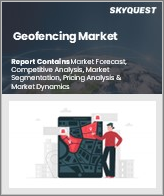
지오펜싱 세계 시장 규모는 2023년에 24억 달러로 평가되었으며, 2024년 29억 달러에서 2032년까지 131억 5,000만 달러로 성장하고, 예측 기간(2025-2032년) 동안 CAGR 20.8%로 성장할 전망입니다.
스마트폰과 웨어러블 기술의 보급은 지오펜싱 세계 시장 성장을 크게 촉진하고 있습니다. 소비자의 위치정보 서비스에 대한 관심이 높아지면서 기업은 지오펜싱을 활용하여 가상의 경계를 만들고, 고객 참여를 높이고, 판매를 촉진하는 타겟 알림, 프로모션, 광고를 촉진할 수 있습니다. 모바일 기기의 사용 급증은 특히 소매, 물류, 헬스케어 등의 분야에서 지오펜싱 솔루션에 대한 수요를 증가시키고 있습니다. 또한 사물인터넷(IoT) 기술의 발전은 이 시장에서 매우 중요한 역할을 하고 있습니다. 커넥티드 디바이스의 확산으로 인해 추적 기능이 향상되고 산업 간 원활한 통합이 가능해졌기 때문입니다. 소매업체는 IoT 센서를 활용하여 소비자의 움직임을 실시간으로 추적하고, 물류업체는 지오펜싱을 통해 차량 관리를 강화하여 개인화된 경험과 업무 효율을 높이고 있습니다.
Global Geofencing Market size was valued at USD 2.4 billion in 2023 and is poised to grow from USD 2.9 billion in 2024 to USD 13.15 billion by 2032, growing at a CAGR of 20.8% during the forecast period (2025-2032).
The rising adoption of smartphones and wearable tech is significantly propelling global geofencing market growth. As consumers increasingly engage with location-based services, businesses can leverage geofencing to create virtual perimeters, facilitating targeted notifications, promotions, and advertisements that enhance customer engagement and drive sales. The surge in mobile device usage amplifies the demand for geofencing solutions, particularly within sectors like retail, logistics, and healthcare. Furthermore, advancements in Internet of Things (IoT) technology play a pivotal role in this market, as the proliferation of connected devices allows for improved tracking and seamless integration across industries. Retailers utilize IoT sensors for real-time consumer movement tracking, while logistics companies enhance fleet management with geofencing, fostering personalized experiences and operational efficiencies.
Top-down and bottom-up approaches were used to estimate and validate the size of the Global Geofencing market and to estimate the size of various other dependent submarkets. The research methodology used to estimate the market size includes the following details: The key players in the market were identified through secondary research, and their market shares in the respective regions were determined through primary and secondary research. This entire procedure includes the study of the annual and financial reports of the top market players and extensive interviews for key insights from industry leaders such as CEOs, VPs, directors, and marketing executives. All percentage shares split, and breakdowns were determined using secondary sources and verified through Primary sources. All possible parameters that affect the markets covered in this research study have been accounted for, viewed in extensive detail, verified through primary research, and analyzed to get the final quantitative and qualitative data.
Global Geofencing Market Segments Analysis
Global Geofencing Market is segmented by Component, Geofencing Type, Organization Size, Vertical and region. Based on Component, the market is segmented into Solution and Services. Based on Geofencing Type, the market is segmented into Fixed Geofencing and Mobile Geofencing. Based on Organization Size, the market is segmented into Small and Medium-Sized Enterprises and Large Enterprises. Based on Vertical, the market is segmented into Transportation and Logistics, Retail, Healthcare and Life Sciences, Industrial Manufacturing, Media and Entertainment, Government and Defense, BFSI and Others. Based on region, the market is segmented into North America, Europe, Asia Pacific, Latin America and Middle East & Africa.
Driver of the Global Geofencing Market
The global geofencing market is primarily fueled by the swift rise in smartphone usage. With an increasing number of consumers relying on mobile devices, businesses have the opportunity to leverage geofencing to enhance customer engagement through location-based services, promotional offers, and tailored messaging. As mobile phone adoption continues to surge, more companies are integrating geofencing technology into their targeted advertising strategies, allowing them to reach customers more effectively and personally. This trend not only facilitates better interaction with potential clients but also drives the overall demand for geofencing solutions across various industries, further propelling market growth.
Restraints in the Global Geofencing Market
The Global Geofencing market faces significant constraints due to regulatory challenges, especially in regions characterized by stringent data protection laws. Compliance with regulations like the General Data Protection Regulation (GDPR) in the European Union, along with various local privacy laws, can be both complex and costly for organizations. As companies strive to ensure their geofencing solutions meet these legal requirements, they often find themselves needing to allocate substantial resources for compliance efforts. This investment can hinder their ability to deploy geofencing technologies on a large scale, ultimately limiting growth opportunities within the market.
Market Trends of the Global Geofencing Market
The Global Geofencing market is witnessing a notable trend towards the increased integration of artificial intelligence (AI) technologies, enhancing the capabilities of traditional geofencing solutions. This evolution allows for more precise location tracking and empowers businesses to execute targeted marketing campaigns through predictive analytics. With AI-driven insights, companies can optimize operations, streamline logistics, and refine customer engagement strategies, leading to enhanced consumer experiences. Furthermore, real-time data utilization fosters greater automation within geofencing applications, enabling businesses to respond swiftly to dynamic market conditions. As AI continues to shape operational efficiencies, the geofencing market is projected to experience significant growth and innovation in the coming years.